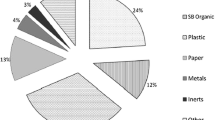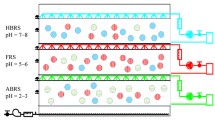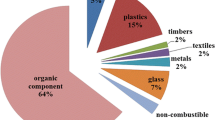Abstract
About seven million tons of residual waste are treated in mechanical–biological and mechanical–physical waste treatment plants (MBT) in Germany every year. Organosilicon compounds are getting released during the process of aerobic waste treatment and lead to cost intensive clogging problems in the exhaust gas treatment systems. Release of volatile methyl siloxanes (VMSs) in MBT plants as well as biological filtering as a gas treatment option were investigated in order to develop a strategy to reduce VMSs in the exhaust gas of the rotting process. This paper presents the results of a comprehensive measurement series at Germany’s largest MBT plant in terms of VMSs release during the intensive rotting process as well as investigations on the reduction of these compounds when using biological filters. Regarding the intensive rotting process we found the main release of VMSs during the first days of the process as well as a dependency between VMSs release on oxygen supply. Investigations at the biological filter of an Austrian MBT plant revealed VMSs reduction rates up to 80 %. Similar effects were also observed by investigations at a biofilter test facility over a testing period of 7 months. First results of experiments with bacteria indicate an unspecific contribution of microbial biomass to the VMSs reduction effects in biofilters.








Similar content being viewed by others
References
Hoffmann, G., Wünsch, C., Brunn, L., Schnapke, A., Schingnitz, D., Günther, M., Baumann, J., Wagner, J., Bilitewski, B.: Umweltforschungsplan des Bundesministeriums für Umwelt, Naturschutz und Reaktorsicherheit-Abfallwirtschaft-Nutzung der Potenziale des biogenen Anteils im Abfall zur Energieerzeugung, Förderzeichen (UFOPLAN) 370733303. Institut für Abfallwirtschaft und Altlasten der TU Dresden und INTECUS GmbH, Bearbeitung (2010)
Wallmann, R., Dorstewitz, H., Hake, J., Santen, H., Fricke, K.: Betriebserfahrungen mit der Abluftbehandlung nach 30. BImSchV. Müll Abfall 6, 209–304 (2006)
Reindorf T., Carlowitz O., Neese O.: Übersicht über Anwendungsgebiete, Funktionsweise und Entwicklungsbedarf der thermischen Abgasreinigung mit regenerativer Abluftvorwärmung, In: Kühle-Weidemeier, M. (ed.) International Symposium MBT 2005, Göttingen, pp. 234–249 (2005)
Mattersteig S., Brunn L., Hohmann F., Friese M., Bilitewski B.: Siloxane im Biogas und in der Rotteabluft biologischer Abfallbehandlungsanlagen, Berliner Abfallwirtschafts- und Energiekonferenz, 25th and 26th of September 2008, Conference paper, Berlin (2008)
30. BImSchV: Dreißigste Verordnung zur Durchführung des Bundesimmissionsschutzgesetzes, 8. Verordnung über Anlagen zur biologischen Behandlung von Abfällen, 20.02.2001, BGBl. I, p. 317, Last Amendement 27.04.2009, BGBl. I, p. 900 (2001)
Cuhls C.: Schadstoffbilanzierung und Emissionsminderung bei der mechanisch-biologischen Abfallbehandlung. Dissertation Universität Hannover, Fachbereich Bauingenieur- und Vermessungs- wesen (1999)
VDI 3475 (1): VDI guideline, Emission control—Biological waste treatment facilities—Composting and anaerobic digestion—Plant capacities more than approx. 6000 Mg/a, part 1, January (2001)
VDI 3475 (3): VDI guideline, Emission control Mechanical-biological treatment facilities for municipal solid waste, part 3, December (2006)
Noll, W.: Chemie und Technologie der Silicone, 2nd edn. Verlag Chemie, Weinheim (1968)
Held W.: Silicone. In: Domininghaus, H., Elsner P., Eyerer, P., Hirth T. (eds.) Kunststoffe—Eigenschaften und Anwendungen, pp. 1156–1173. Springer, Berlin (2008)
Lynch W.: Handbook of silicone rubber fabrication, p. 1 et sqq. Van Nostrand Reinhold Company, New York (1978)
CES: A Socio-Economic Study on Silicones in Europe. European Silicones Centre, Brüssel. http://www.silicones.eu/socioeconomic/ (2008)
Reuther, H.: Silikone, Ihre Eigenschaften und Ihre Anwendungsmöglichkeiten, 2. Auflage, Dresden (1969)
Reller, A., Braungart, M., Soth, J., Uexküll, O.: Silicone-eine vollsynthetische Materialklasse macht Geschichte(n). Gaia 9(1), 13–24 (2000)
ZZulV: Verordnung über die Zulassung von Zusatzstoffen zu Lebensmitteln zu technologischen Zwecken (Zusatzstoff-Zulassungsverordnung), 29.01.1998, BGBl. I, p. 230-231, Last Amendement 21.05.2010, BGBl. I p. 674 (1998)
Kaj L., Schlabach M., Andersson J., Cousins A.P., Schmidbauer N., Brorström-Lundén E.: Siloxanes in the nordic environment, download 14 Feb 2010. http://www.norden.org/da/publikationer/publikationer/2005-593/at_download/publicationfile (2005)
Atkinson, R.: Kinetics of the gas-phase reactions of a series of organosilicon compounds with OH and NO3 radicals and O3 at 297 ± 2 K. J. Environ. Sci. Tech. 25, 863–866 (1991)
Sommerlade, R., Palar, H., Wrobel, D., Kochs, P.: Product analysis and kinetics of gas-phase reactions of selected organosilicon compounds with OH radicals using smog chamber-mass spectrometer system. J. Environ. Sci. Tech. 27, 2435–2440 (1993)
Buch, R.R., Ingebrigtson, D.N.: Rearrangement of polydimethylsiloxane fluids in soil. J. Environ. Sci. Tech. 13(6), 676–679 (1979)
Lehmann, R.G., Varaprath, S., Annelin, R.B., Arndt, J.L.: Degradation of silicone polymer in a variety of soils. J. Environ. Toxicol. Chem. 14, 1299–1305 (1995)
Sabourin, C.L., Carpenter, J.C., Leib, T.K., Spivack, J.C.: Biodegradation of dimethylsilanediol in soils. Appl. Environ. Microbiol. 62(12), 4352–4360 (1996)
Watts, R.J., Kong, S., Haling, C.S., Gearhart, L., Frye, C.L., Vigon, B.W.: Fate and effects of polydimethylsiloxanes on pilot and bench-top activated sludge reactors and anaerobic/aerobic digesters. Water Res. 29(10), 2405–2411 (1995)
Oku, A., Huang, W., Ikeda, Y.: Monomer recycling for vulcanized silicone rubbers in the form of cyclosiloxane monomers. Role of acid buffers. Polymer 43, 7289–7293 (2002)
Grümping, R., Michalke, K., Hirner, A.V., Hensel, R.: Microbial degradation of octamethylcyclotetrasiloxane. Appl. Environ. Microbiol. 65(5), 2276–2278 (1999)
Accettola F., Guebitz G.M., Schoeftner R.: Siloxane removal from biogas by biofiltration: biodegradation studies. Clean. Technol. Environ. Policy, 211–218 (2008)
Fischer-Reinhard M.: Mikrobieller Abbau von Siliconölen, Siloxanen und Silanolen. Dissertation, TU Darmstadt (2007)
Mattersteig S.: Siloxane in mechanisch-biologischen Abfallbehandlungsanlagen. Dissertation, Beiträge zu Abfallwirtschaft/Altlasten Band 71, Schriftenreihe des Institutes für Abfallwirtschaft und Altlasten, Technische Universität Dresden (2011)
DIN EN 12619: Stationary source emissions—determination of the mass concentration of total gaseous organic carbon—continuous flame ionisation detector method; German version: prEN 12619: 2011, February (2011)
VDI 3481 (4): VDI guideline, Gaseous emission measurement–measurement of the concentration of total organic carbon and methane carbon using the flame ionisation detector (FID), part 4, February (2007)
DIN EN 15058: Stationary source emissions—determination of the mass concentration of carbon monoxide (CO)—reference method: non-dispersive infrared spectrometry; German version: EN 15058: 2006, September (2006)
DIN EN ISO 21258: Stationary source emissions—determination of the mass concentration of dinitrogen monoxide (N2O)—reference method: non-dispersive infrared method (ISO 21258:2010); German version EN ISO 21258: 2011, November (2010)
Hellebrand H.-J.: Lachgasemissionen beim Kompostieren, Internet download on 27th August 2009. Available on: http://www.atb-potsdam.de/hauptseite-deutsch/index2.htm (1999)
Acknowledgments
The project was supported by the EFRE—European Funds for Regional Development and by funds of the Free State of Saxony.
Author information
Authors and Affiliations
Corresponding author
Rights and permissions
About this article
Cite this article
Brunn, L., Mattersteig, S., Lorbeer, H. et al. Release and Reduction of Organosilicon Compounds in MBT-Plants. Waste Biomass Valor 4, 455–465 (2013). https://doi.org/10.1007/s12649-012-9184-9
Received:
Accepted:
Published:
Issue Date:
DOI: https://doi.org/10.1007/s12649-012-9184-9




